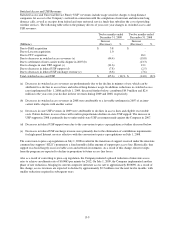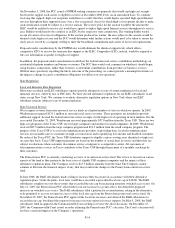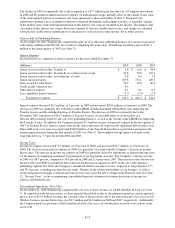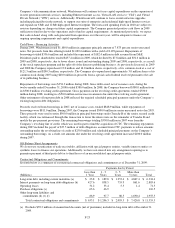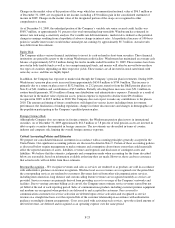Windstream 2009 Annual Report Download - page 129
Download and view the complete annual report
Please find page 129 of the 2009 Windstream annual report below. You can navigate through the pages in the report by either clicking on the pages listed below, or by using the keyword search tool below to find specific information within the annual report.
On February 17, 2009, the American Recovery and Reinvestment Bill of 2009 was signed into law that includes
various financial incentives to qualifying entities for the expansion of broadband services in both unserved and
underserved communities throughout the nation. The legislation allocates approximately $7.0 billion for the expansion
of both wired and wireless broadband services. The Company elected not to participate in the application process for
the first round of stimulus funding, which was released during 2009. After a careful review of the program rules, the
Company determined that the rules applicable to the first round of funding did not allow for a sound and sustainable
business case. The Company is currently reviewing the rules applicable to the second round of funding and evaluating
whether it should participate in the application process.
As part of the American Recovery and Reinvestment Act (“ARRA”), Congress directed the FCC to report to Congress
by mid-February with a National Broadband Plan. In conjunction with this report, it is expected that the FCC will
consider a myriad of issues related to high-speed Internet access deployment and adoption and, among other things,
may consider universal service and intercarrier compensation reform. On December 7, 2009, Windstream, CenturyTel,
Inc, Frontier Communications Corporation, Consolidated Communications Holding, Inc and Iowa Telecom filed a plan
with the FCC to reform the intercarrier compensation and universal service mechanisms and further deploy broadband
in unserved areas. If adopted, the proposal would stabilize intercarrier compensation and universal support and provide
additional funds to Windstream to assist with the deployment of broadband services to rural areas.
Price-Cap Petition Granted by FCC
Effective July 1, 2008, the Company converted the majority of its remaining interstate rate-of-return regulated
operations to price-cap regulation. Price-cap regulation better aligns the Company’s continued efforts to improve its
cost structure, because rates for interstate wholesale services are not required to be periodically adjusted based on the
Company’s cost structure, and under price-cap regulation, high-speed Internet services can be deregulated. As
previously discussed, high-speed Internet services were deregulated effective July 1, 2008. Prior to the conversion,
with the exception of our Nebraska and New Mexico operations, and a portion of our Kentucky, Oklahoma and Texas
operations, our interstate ILEC operations were subject to rate-of-return regulation by the FCC.
Inter-carrier Compensation
The Company’s local exchange subsidiaries currently receive compensation from other telecommunications providers,
including long distance companies, for origination and termination of interexchange traffic through network access
charges that are established in accordance with state and federal laws.
On November 5, 2008, the FCC issued a further notice of proposed rulemaking (“FNPRM”) that sought comment on
proposals that would change the rules governing inter-carrier compensation. Proposals considered by the FNPRM
would significantly reduce inter-carrier compensation revenues over a ten-year period, classify VoIP/public switch
telephone network (“PSTN”) traffic as an “information service,” and adopt measures to ensure proper billing of
“phantom traffic”. Windstream strongly supports regulatory reform, but with the exception of the phantom traffic
reforms, Windstream is opposed to the inter-carrier compensation proposals under consideration by the FNPRM. We
have submitted an alternative proposal that includes a measured reduction in access rates, increases in subscriber line
charges, and additional federal universal service support.
The FCC has received other proposals to reform inter-carrier compensation mechanisms. If the Commission acts, the
outcome is likely to change the way the Company receives compensation from, and remits compensation to, other
carriers and its end-user customers, as well as the federal universal service fund. Until these proceedings conclude and
any changes to the existing rules are established, the Company cannot estimate the impact of any changes on its ILEC
revenues or expenses or when such changes would occur.
Universal Service
The federal universal service program is under legislative, regulatory and industry scrutiny as a result of the growth in
the fund and structural changes within the telecommunications industry. The primary structural change is the increase
in the number of Eligible Telecommunications Carriers (“ETCs”) receiving money from the USF. There are several
FCC proceedings underway that are likely to change the way the universal service programs are funded and the way
universal service funds are disbursed to program recipients. The specific proceedings are discussed below.
On May 1, 2008, the FCC released an order adopting an interim, emergency cap on the amount of high-cost support
that competitive ETCs may receive. Competitive ETC support will be capped in each state at the amount competitive
ETCs were eligible to receive in such state during March 2008 on an annualized basis. The Company’s high-cost
support was not affected by the FCC’s order.
F-15






